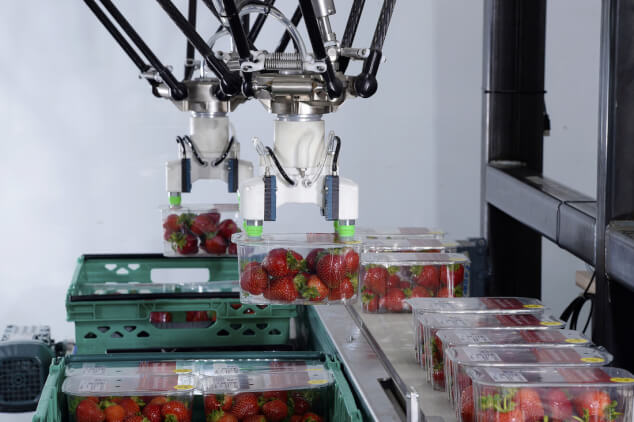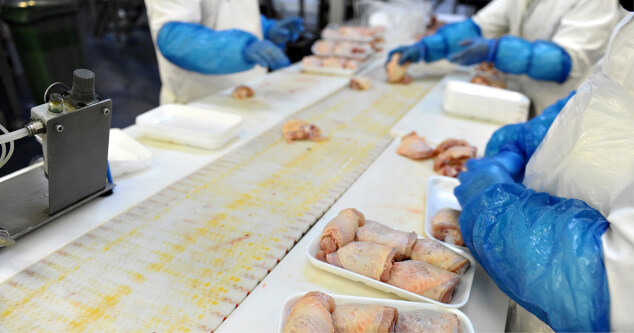Digitally Transform your Food Production Line using Smart Pick and Place Robot
Published on 17 November, 2021 in Flexible Manufacturing
A once in a generation labour shortage has put the UK food industry in a precarious position. Through a combination of Covid and Brexit, fewer workers being available is placing significant strains on food production and supply chains. A lack of:
- Delivery drivers
- Production line workers
- Fruit pickers
- Abattoir staff
- And other workers
Has led to instances of empty supermarket shelves with a growing number of missed food deliveries. Our food supply chains are beginning to feel the bite.
Labour shortages mean employers have to offer higher wages. For example, the Association of Independent Meat Suppliers (AIMS) has stated meat processing firms are paying at least 10% more for staff than before the pandemic.
Stark increases in labour costs for food industry firms get passed on to consumers. As a result, some within the food industry are warning of a 5% food price increase.
The shortage of food workers and its knock-on effects require companies to look at new production approaches, finding ways to do more with less.
Fortunately, many tasks within the food production industry are perfect fits for the integration of automation technology. For example, jobs like sorting and container filling are now possible using sophisticated pick and place robotics. In particular, advances in high-speed delta robots offer a range of food production benefits in terms of speed, accuracy, and more.

Workforce shortages in the food industry
Much focus recently has been on the severe shortage of drivers. However, the current situation is not just a problem of logistics, but a broader labour crisis across the food industry, including:
- Production
- Harvesting
- Manufacturing
- Packaging
European workers often filled jobs in these low-paid sectors. However, with Brexit and Covid restrictions, a significant proportion of these workers have returned home and are no longer available to employers.

Other factors compounding the labour shortage are:
- New visa requirements for unskilled workers
- The winding down of the furlough scheme
- Workers using holiday time accumulated during furlough for summer breaks
- A reduction in overseas holidays lessening the usual summer drop in food demand
The Association of Labour Providers (ALP) surveyed 99 food and drink firms in the UK. Their report shows that 78% do not expect sufficient workers in 2021 and will likely fail to meet their clients’ demands. A quarter said they were in crisis and would have to reducetheir output.
With demand higher than supply, food prices are only going to go in one direction. And the increase in food price forecast could have devastating effects on society. With the pandemic’s economic repercussions, many family’s are already struggling to get by.
Increasing the outgoings required to feed themselves could be the final straw pushing many more into debt. The increase in foodbank usage presents just how serious the problem of food poverty currently is.
Statistics show approximately 2.5 million people used a foodbank in 2020/2021, increasing by over 600 thousand compared to the previous year.
Food Production line shortages
Workers on production lines are responsible for producing, manufacturing, sorting, and packaging much of the food we eat. Typically, they work in a factory/warehouse-like environment and use machinery to output bulk amounts.
First and foremost among their responsibilities is ensuring the food output is safe to consume and meets the expected standard. This means implementing stringent health and safety practices.
Food production machinery in the modern world has come a long way. In developed countries, the efficiency of its use has helped feed the growing population. A natural extension to food production machinery is automation technology.
Many food production line tasks are made better via the use of high-speed delta robotics. For example, they can pick and sort through different foods, placing them in containers for the next job in the line.
Food Production Automation
Automation technology is digitally transforming food production. Using automated solutions to replace humans for repetitive tasks offers a range of benefits:
- Greater efficiency – automation leads to higher output rates. With only occasional breaks for maintenance, the technology can work almost non-stop.
- Improved quality control – many processes can be difficult for human monitoring and are enhanced using technology.
- Worker safety – automation eliminates the need for humans to perform jobs requiring repetitive motion that lead to injury.
- Traceability – combining automation with analytics allows full traceability throughout the supply chain.
- Waste reduction - with automation, you gain greater control of your production lines output, reducing waste present in the system.
These are all great reasons to integrate automation within food production. But the current labour shortages are a massive reason for automation right now. Alleviate the stress and strain on your company caused by a lack of workers and let technology show you how to meet your client’s demands. Save money and attract new customers by passing these savings on to them at a difficult time for society.
Pick and Place Robotics
With pick and place robotics, your production line gets a technological boost in efficiency and accuracy. Advances in high-speed delta robotics allow for a ramp-up in production output while maintaining the quality standards your clients expect.
Whether it is production, inspection, sorting, or packaging, robotic automation offers greater productivity and fewer mistakes, helping to reduce costly recalls.
